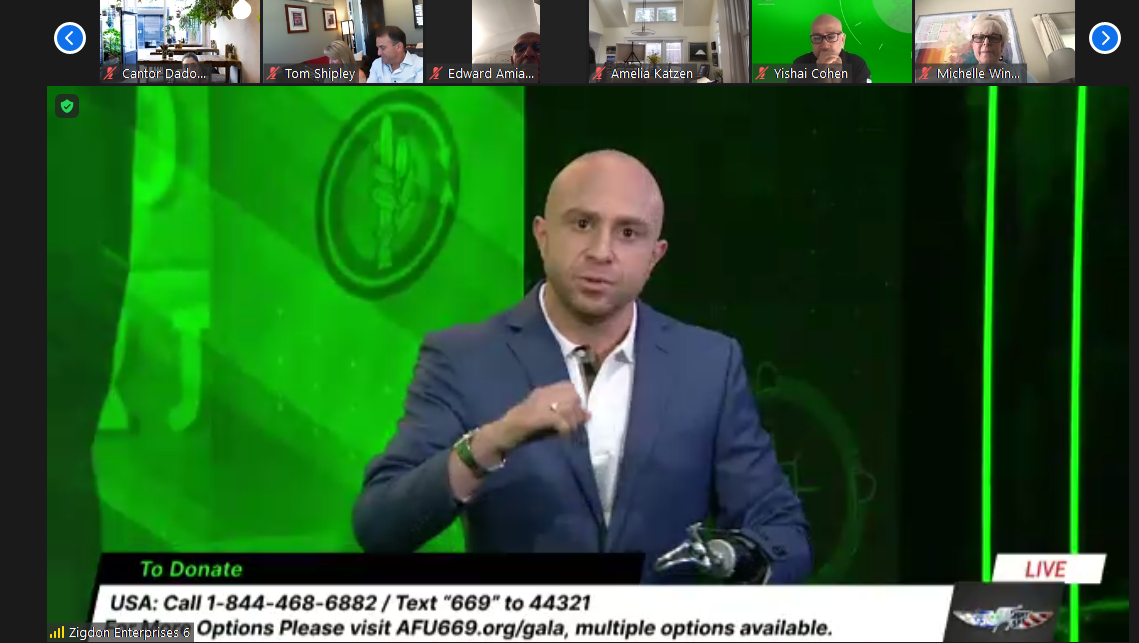
Featured Item

Saving lives all in a day’s work for Unit 669
When Baltimore resident Isaac Pretter took his family paragliding off the coast of Herzliya in Israel, he never imagined it could end in a tragedy. The reason it didn’t was because of the swift action of the Israeli Defense Force’s (IDF’s) elite Unit 669.
“We watched our other daughter, Rina, land safely, and waited to see Leah and her instructor land just after them,” Pretter said, recalling the frightening event of 2019. “When they didn’t, I asked my instructor where they were. He pointed at a ledge in the distance, and said, ‘They crashed’.”
Pretter was horrified to see his daughter dangling from a ledge, suspended 100m over the Mediterranean. Trapped in a harness, Leah was unable to free herself or her instructor, who had been knocked unconscious.
“There were jagged rocks everywhere,” Pretter told a gala online event honouring Unit 669, Israel’s specialised combat search and rescue division. “We got closer, and I could hear my daughter screaming. The strings of her parachute were caught on a ledge, and though we could reach it, the guide said that if we pulled it, it might rip, and she’d fall. It was terrifying.”
Someone contacted Unit 669, and a helicopter was dispatched in record time.
“That wait was the longest one of my life, but when I heard the helicopter blades and saw a solider rappelling down to me, I felt safe immediately,” recalled Leah at the online event that was broadcast live this week from Israel by the American Friends of Unit 669. “He was risking his life to save mine. I’ll never forget how that felt.”
Leah was successfully transported to hospital and discharged with a few injuries 24 hours later. She is just one of the 12 000 individuals whose lives were saved by Unit 669 in its 47 years of operation.
Founded in 1974 in the wake of the Yom Kippur War, Unit 669 was initially established to save Israeli pilots behind enemy lines. Today, it’s responsible for the rescue and evacuation of all IDF personnel, from ground forces to naval commandoes.
The unit also serves Israel’s civilian population in its moment of need, whether it be mass casualty accidents, terror attacks, car accidents, or even stranded injured hikers. Additionally, Unit 669 participates regularly in missions beyond the borders of Israel, civilian and military, Israeli and foreign.
The unit is divided into three major divisions: combat, medical, and logistics. Combat fighters are trained in high-angle rope techniques, water, and scuba diving skills, medical training, and aerial rescue methods. The medical division is made up of Israel’s top doctors and paramedics, who have a history of combat training and can administer care in the most difficult circumstances. The logistics division supports the unit’s operational capabilities.
IDF veteran Ziv Shilon was also saved by the heroic actions of the unit. A former officer of the Givati Brigade, he was severely wounded on the Gaza Strip in 2012 when an explosion ripped off his left hand.
“It was the last day of my service,” Shilon recounted during the livestream. “Our mission was to confirm that there were no terrorists at the Gaza border.
“At 06:00, near the end of the mission, I was preparing to open the border gate to allow my team back into Israel. Because of the threat level, I ordered my soldiers to wait behind and cover me and I crawled to the gate. I arrived, opened the lock, and pushed the gate open.”
A sudden explosion rent the air as Shilon stepped back from the gate: he had tripped a wire attached to the fence rigged to an explosive charge. Shilon felt excruciating pain, as though he was on fire, and opened his eyes to see that his left hand was missing.
“There was blood everywhere,” he recalled. “My left hand was gone. My right hand wouldn’t move, and I could see why: it was almost disconnected from my arm, hanging by a few shreds of flesh.
“I had to conquer my shock, or I knew I would bleed out and die. My main concern was being kidnapped, and I had no hands to defend myself. With the last of my strength, I picked up what was left of my hand, stood up and ran with all my gear still on to my team.”
After a stunned medic bandaged Shilon’s arms, the unit hastily left the scene, and headed to the landing ground nearby where a Unit 669 helicopter waited for them.
“During the flight, a Unit 669 medic worked to stabilise me. I looked her in eye and asked her if I would live. She answered, ‘Don’t worry, we will save you.’ What she said came true, and the medical treatment I received did save my life.”
Shilon was given 56 units (30 litres) of blood, underwent eight surgeries over two weeks, and realised that his life had changed forever.
“I was angry, disappointed, and scared. I couldn’t eat by myself anymore,” he said. “I had lost one hand, and couldn’t use the other. I had lost hope. I realised I had to give myself a reason to live.”
In spite of his pain and loss, Shilon resolved to return to the army, and five months later, was again in uniform. Although he still had to undergo months of rehabilitation and a further nine surgeries, he took up studies at IDC (Interdisciplinary Centre) Herzliya, married, and even competed in five marathons and the Iron Man triathlon in Berlin, swimming and riding a bike without the use of his hands.
“I learned how to live life again, and developed a special academic programme for soldiers like me to give them the opportunity to earn a new life after their trauma. I’ve developed creative solutions for writing and driving, and I’m the only person I know who, in spite of not having hands, can flip burgers without getting burned.
“I’m living evidence of Unit 669’s role in saving lives. It saved me.”










